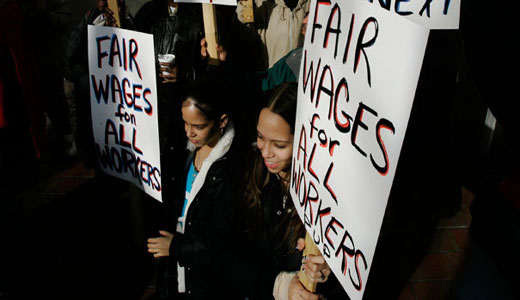
You wouldn’t know it from the media, especially Fox, but even including some National Public Radio hosts, the Congressional Budget Office (CBO) report on the minimum wage sided with supporters of increasing the federal wage floor.
The only major exception -which has nonetheless dominated media coverage – was the impact on employment. Here, its is hard not to question the credibility of CBO Executive Director Doug Elmendorf, who at one time had a decent reputation as an economist, but then accepted the role of chief economic spokesperson for the Romney presidential campaign, which quickly lost all connection with the truth.
AFL-CIO President Richard Trumka captured a key aspect of this controversy: “Every time momentum builds for lifting wages, conservative ideologues say it will cost jobs. Every time they’ve been dead wrong. Being consistently wrong and not caring about workers are the only two things conservative economists can be counted on for. This is more of the same noise. They want subservient, scared workers whose suffering will expand their stock portfolios. Our country is finally poised to lift millions out of poverty and make our country work for the people who work. Let’s raise the wage and we’ll prove the CBO wrong again.”
Economists have conducted hundreds of studies of the employment impact of the minimum wage. Summarizing those studies is a daunting task, but two recent meta-studies analyzing the research conducted since the early 1990s concludes that the minimum wage has little or no discernible effect on the employment prospects of low-wage workers.
The CBO report is mostly positive on raising the minimum wage. Why?
The minimum wage will directly benefit tens of millions of workers. As Economist John Schmidt of CEPR writes: “Opponents of the minimum wage like to cite Bureau of Labor Statistics (BLS) numbers that suggest that there are only about 1.6 million minimum-wage workers, ignoring that this figure refers only to worker who earn exactly the federal minimum wage of $7.25 per hour. CBO, instead, estimates that about 16.5 million workers would receive a wage increase because the CBO correctly factored in that millions more workers who earn between the current federal minimum wage and the new proposed level of $10.10 would also receive a pay increase.”
The CBO estimate of the total direct beneficiaries is almost identical to the 16.7 million worker estimate produced by the Economic Policy Institute. The minimum wage will indirectly raise the wages of millions more.
Raising the bottom always leads to restructurings that reach all the way up the wage and salary scales of every economic sector. It’ s simple -more overall income goes to labor, than to capital. Interesting the even liberal “capitalists”, like Bill Gates, are in solidarity with their billionaire brethren opposed to raising the minimum wage. Opponents also argue that the typical minimum wage worker is a suburban teenager living with middle or upper class parents. However, the CBO concludes, according to Schmidt, “that only 12 percent of these low-wage workers are teenagers, 10 percent have a college degree, and more than half (53 percent) work full time. “
The minimum wage will reduce poverty.
The CBO report concluded that an increase in the minimum wage to $10.10 would lift 900,000 people out of poverty, a number far lower than the 4.6 to 6.8 million people for whom economist Arindrajit Dube claims would be lifted out of poverty after full implementation.
The CBO also accepted the elementary Keynesian argument that increasing the incomes of low-wage workers – who tend to spend a very high share of what they earn – will act as a stimulus to the broader economy.
CBO writes: “On balance, according to CBO’s analysis, raising the minimum wage would increase demand for goods and services … [by shifting] income from business owners and consumers (as a whole) to low-wage workers. Low-wage workers generally spend a larger share of each dollar they receive than the average business owner or consumer does; thus … overall spending increases.”
Whenever efforts to increase the minimum wage gain momentum, opponents suggest expanding the Earned Income Tax Credit (EITC) instead. The tax credit, it is true, targets working poor families with, in effect, a government subsidy. But its really a subsidy to the employer, allowing him to pay a lower than fair market wage at the taxpayer expense.
There is every reason to support both approaches, really. The tax credit approach targets the right people broadly speaking, but the minimum wage sets ceiling on government subsidies for employer responsibilities to pay a fair wage. “The two policies work well together,” writes Schmidt. “The EITC [tax credit] raises wages for low-income workers to where a minimum wage of the same level would likely cause job loss. Meanwhile, the minimum wage ensures that the benefits of the EITC go to workers, not employers.”
CBO acknowledges these important issues, and concludes: “An increase in the minimum wage would shift some of that benefit [that accrues to employers, rather than to workers] from employers to workers by requiring the former to pay the latter more.”
Photo: AP












Comments